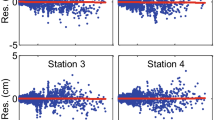Abstract
Ambiguity resolution (AR) speed is one of the most important performance indicators of a network RTK (real-time kinematics) system. Given the low correlation between the error sources of two stations, the effect of the atmospheric delay of double-difference observations cannot be ignored, thus making it difficult to fix the ambiguities. Ionospheric delay is one of the largest error sources affecting AR. This error source is reduced by the ionospheric-free combination with traditional methods. The AR speed of these methods is slow; generally, tens of minutes and even more are required for initialization. This study proposes an ionospheric model constraint (IMC) method to improve the AR speed. External information is not required apart from observations. The double-difference ionospheric delay is described with a regional double-difference ionospheric model, the coefficients of which are estimated as parameters together with ambiguities and tropospheric delays. Experimental results show that the initialization speed significantly improves by 72.5 % and that the AR speed for the newly risen satellites increases by 84.3 % with the proposed IMC method. Furthermore, the percentage of correctly fixed integer ambiguities after initialization increases to some extent.










Similar content being viewed by others
References
Abidin HZ (1993) Computational and geometrical aspects of ‘on the fly’ ambiguity resolution. Technical Report No. 164, Department of Surveying Engineering, University of New Brunswick, Fredericton, NB, Canada
Bock Y, Gourevitch SA, Counselman CC, King RW, Abbot RI (1986) Interferometric analysis of GPS phase observations. Manuscr Geod 11(4):282–288
Boehm J, Niell A, Tregoning P, Schuh H (2006) Global mapping function (GMF): a new empirical mapping function based on numerical weather model data. Geophys Res Lett 33(7):L07304
Chen HY, Rizos C, Han S (2004) An instantaneous ambiguity resolution procedure suitable for medium-scale GPS reference station networks. Surv Rev 37(291):396–410
Dai L, Wang J, Rizos C, Han S (2003a) Predicting atmospheric biases for real-time ambiguity resolution in GPS/GLONASS reference station networks. J Geod 76(11–12):617–628
Dai L, Han S, Wang J, Rizos C (2003b) Comparison of interpolation algorithms in network-based GPS techniques. Navigation 50(4):277–293
Dong DN, Bock Y (1989) Global positioning system network analysis with phase ambiguity resolution applied to crustal deformation studies in California. J Geophys Res Solid Earth 94(B4):3949–3966
Euler HJ, Schaffrin B (1991) On a measure for the discernibility between different ambiguity solutions in the static-kinematic GPS-mode. In: Kinematic systems in geodesy, surveying, and remote sensing. Springer, New York, 285–295
Fotopoulos G, Cannon ME (2001) An overview of multi-reference station methods for cm-level positioning. GPS Solut 4(3):1–10
Gao Y, Li Z, McLellan JF (1997) Carrier phase based regional area differential GPS for decimeter-level positioning and navigation. In: Proceedings of ION GPS 1997, Institute of Navigation, Kansas City, Missouri, 16–19 September, pp 1305–1313
Goad CC, Yang M (1997) A new approach to precision airborne GPS positioning for photogrammetry. Photogramm Eng Remote Sens 63(9):1067–1077
Han S, Rizos C (1996) GPS network design and error mitigation for real-time continuous array monitoring systems. In: Proceedings of ION GPS 1996, Institute of Navigation, Kansas City, Missouri, 17–20 September, 1827–1836
Hu G, Abbey DA, Castleden N, Castleden N, Featherstone WE, Earls C, Ovstedal O, Weihing D (2005) An approach for instantaneous ambiguity resolution for medium-to long-range multiple reference station networks. GPS Solut 9(1):1–11
Leandro R, Santos MC, Langley RB (2006) UNB neutral atmosphere models: development and performance. In: Proceedings of ION NTM 2006, Institute of Navigation, Monterey, CA, 18–20 January, pp 564–573
Liu G C, Lachapelle G (2002) Ionosphere weighted GPS cycle ambiguity resolution. In: Proceedings of ION NTM 2002, Institute of Navigation, San Diego, CA, 28–30 January, pp 889–899
Liu JN, Ge MR (2003) PANDA software and its preliminary result of positioning and orbit determination. Wuhan Univ J Nat Sci 8(2):603–609
Odijk D, Teunissen PJG (2010) Improving the speed of CORS network RTK ambiguity resolution. In: Proceedings of IEEE/ION PLANS 2010, Indian Wells, CA, 4–6 May, pp 79–84
Paziewski J (2016) Study on desirable ionospheric corrections accuracy for network-RTK positioning and its impact on time-to-fix and probability of successful single-epoch ambiguity resolution. Adv Space Res 57(4):1098–1111
Schaffrin B, Bock Y (1988) A unified scheme for processing GPS dual-band phase observations. Bull Géod 62(2):142–160
Sieradzki R, Paziewski J (2015) Study on reliable GNSS positioning with intense TEC fluctuations at high latitudes. GPS Solut 20(3):553–563
Teunissen PJG (1995) The least-squares ambiguity decorrelation adjustment: a method for fast GPS integer ambiguity estimation. J Geod 70(1–2):65–82
Teunissen PJG, Joosten P, Tiberius C (1999) Geometry-free ambiguity success rates in case of partial fixing. In: Proceedings of ION NTM 1999, Institute of Navigation, San Diego, CA, 25–27 January, pp 201–207
Wanninger L (1995), Improved ambiguity resolution by regional differential modelling of the ionosphere. In: Proceedings of ION GPS 1995, Institute of Navigation, Palm Springs, CA, 12–15 September, pp 55–62
Wielgosz P (2011) Quality assessment of GPS rapid static positioning with weighted ionospheric parameters in generalized least squares. GPS Solut 15(2):89–99
Acknowledgments
This work is funded by the National High Technology Research and Development Program of China (No. 2012AA12A209). In addition, it is a part of the project “Research on the Perception Technology about the Essential Factor of Chang Jiang Waterway and Its Application” (No. 2013-364-548-200), which is supported by the Chang Jiang Waterway Bureau. This work is also a part of the project “Open Service Platform of Testing BDS Application Products” supported by the Electronic Information Industry Development Fund of the Ministry of Industry and Information Technology of China. All this support is gratefully acknowledged. The authors are grateful to anonymous reviewers for their insightful comments, which have helped to improve the quality of the paper.
Author information
Authors and Affiliations
Corresponding author
Rights and permissions
About this article
Cite this article
Zhang, M., Liu, H., Bai, Z. et al. Fast ambiguity resolution for long-range reference station networks with ionospheric model constraint method. GPS Solut 21, 617–626 (2017). https://doi.org/10.1007/s10291-016-0551-z
Received:
Accepted:
Published:
Issue Date:
DOI: https://doi.org/10.1007/s10291-016-0551-z




